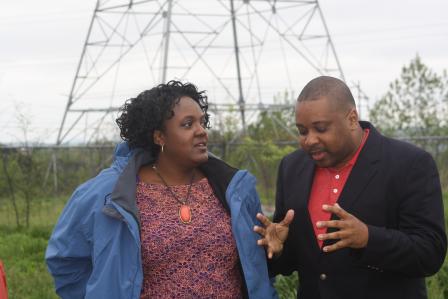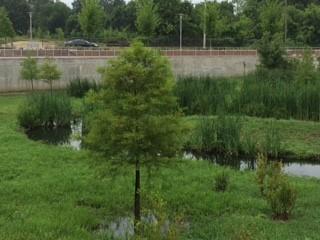Making a Visible Difference in Communities: Alabama
Making a Visible Difference in Communities Home
North Birmingham, AL
EPA engaged in a coordinated approach to evaluate the environmental conditions and potential environmental impacts in low-income and minority communities of Birmingham, AL, including the neighborhoods of Fairmont, Collegeville, and Harriman Park.
These neighborhoods are located in portions of the Village Creek and Five-Mile Creek watersheds.
This area is environmentally overburdened due to the close proximity of heavy industry. EPA has documented releases of pollutants and hazardous substances. The community is concerned about health impacts from industry, safety from heavy train traffic, lack of fresh foods, and economic development.
 Birmingham City Councilor William Parker describes local concerns to EPA Region 4 Administrator Heather Toney during a tour of North Birmingham.
Birmingham City Councilor William Parker describes local concerns to EPA Region 4 Administrator Heather Toney during a tour of North Birmingham. Local children learned about environmental and public health issues during EPA Region 4’s Summer Camp.
Local children learned about environmental and public health issues during EPA Region 4’s Summer Camp.Selma to Montgomery, AL
 EPA’s Clean Water State Revolving Fund helped the City fund this $4 million dollar project that transformed a brownfield site into a wetland that treats storm water.
EPA’s Clean Water State Revolving Fund helped the City fund this $4 million dollar project that transformed a brownfield site into a wetland that treats storm water.
The 54-mile Selma to Montgomery National Historic Trial, designated in 1996 by Congress, commemorates the 1965 Voting Rights March along U.S. Highway 80. This trail begins in Selma and runs through forests and farms, and ends in the state capital of Montgomery.
Communities near the trail want to preserve its history for future generations while reviving the struggling neighborhoods surrounding the trail. EPA worked with Tuskegee University, the National Park Service (NPS), and other local partners to create an alternative transportation plan using selected brownfields along the trail as transit stops and NPS visitor services.
The focus was on development that serves both NPS and rural community economic development needs for health care access and basic shopping services, provides opportunities for job training and creation, and builds capacity for future collaboration on similar challenges related to development, public health and environmental issues of concern.
